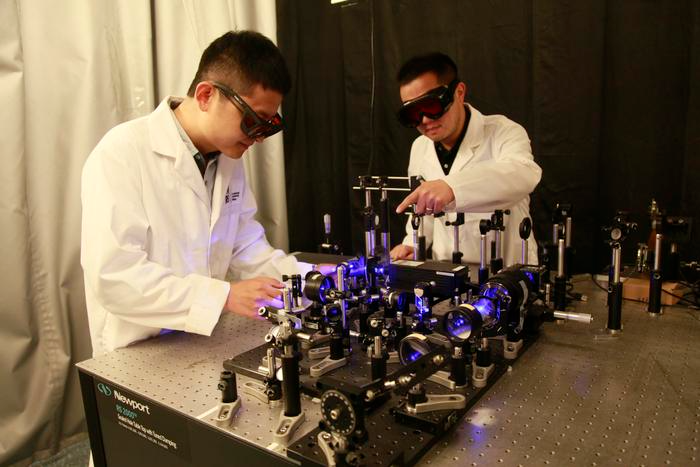Expensive ultrafast cameras that capture millions of images per second are required to capture blur-free images of fast movements like falling water droplets or chemical interactions. Researchers describe a camera in a new study that could provide a far less expensive method of achieving ultrafast imaging for a variety of applications, such as high-speed lidar systems for autonomous vehicles or real-time monitoring of drug delivery.

Researchers developed a diffraction-gated real-time ultrahigh-speed mapping (DRUM) camera that can capture a dynamic event in a single exposure at 4.8 million frames per second. Pictured are researchers Xianglei Liu and Jinyang Liang working on the optical setup. Image Credit: Xianglei Liu and Jinyang Liang, Institut national de la recherche scientifique (INRS)
Our camera uses a completely new method to achieve high-speed imaging. It has an imaging speed and spatial resolution similar to commercial high-speed cameras but uses off-the-shelf components that would likely cost less than a tenth of today’s ultrafast cameras, which can start at close to $100,000.
Jinyang Liang, Associate Professor and Director, Laboratory and Applied Computational Imaging, Institut National de la Recherche Scientifique
Liang and colleagues from Concordia University in Canada and Meta Platforms Inc. demonstrate how their new diffraction-gated real-time ultrahigh-speed mapping (DRUM) camera can record a dynamic event in a single exposure at 4.8 million frames per second in Optica, the journal for high-impact research published by Optica Publishing Group.
To illustrate this ability, they use imaging of the quick dynamics of femtosecond laser pulses interacting with liquid and laser ablation in biological samples.
Liang added, “In the long term, I believe that DRUM photography will contribute to advances in biomedicine and automation-enabling technologies such as lidar, where faster imaging would allow more accurate sensing of hazards. However, the paradigm of DRUM photography is quite generic. In theory, it can be used with any CCD and CMOS cameras without degrading their other advantages such as high sensitivity.”
Creating a Better Ultrafast Camera
Despite significant advancements in ultrafast imaging, current techniques are still costly and difficult to use. Trade-offs between the number of frames recorded in each movie and light throughput or temporal resolution also have an impact on their performance. The researchers created time-varying optical diffraction, a new time-gating technique, to solve these problems.
Gates are used by cameras to regulate when light reaches the sensor. One such gate is the shutter of a conventional camera, which opens and shuts just once. To read out the image in time-gating, the gate must be opened and closed quickly a certain number of times. This captures a scene in a quick, high-speed movie.
Liang discovered how to implement time gating via light diffraction by taking into account the space-time duality of light. He understood that it could be possible to sweep across various spatial places to gate out frames at various times by rapidly varying the tilt angle of periodic facets on a diffraction grating, which can produce multiple copies of the incoming light going in various directions.
An ultrafast movie can subsequently be created by combining these frames. It took a diverse team with specialists in physical optics, ultrahigh-speed imaging, and MEMS design to turn this concept into a functional camera.
“Luckily, it is possible to accomplish this type of swept diffraction gate by using a digital micromirror device (DMD)—a common optical component in projectors—in an unconventional way. DMDs are mass-produced and require no mechanical movement to produce the diffraction gate, making the system cost-efficient and stable,” Liang stated.
Capturing Fast Dynamics
The group developed a DRUM camera with a sequence depth of seven frames, which means that each short video has seven frames. The researchers utilized the technology to capture laser interactions with distilled water after describing its spatial and temporal resolutions.
The ensuing time-lapse images demonstrated the creation of a plasma channel and a bubble in response to a pulsed laser, and the observed bubble radii were in line with those anticipated by cavitation theory. Additionally, they recorded transient interactions between an ultrashort laser pulse and a single-layer onion cell sample, as well as the dynamics of carbonated drink bubbles.
DRUM photography may even be applied to nano-surgeries and laser-based cleaning applications.
Xianglei Liu, Study First Author, Ansys
The performance of DRUM photography is still being improved by the researchers, including increasing the image speed and sequence depth. They also want to investigate how to use the technology for other applications like lidar while simultaneously recording color information.
Journal Reference
Liu, X., et al. (2023) Diffraction-gated real-time ultrahigh-speed mapping photography. Optica. doi:10.1364/OPTICA.495041